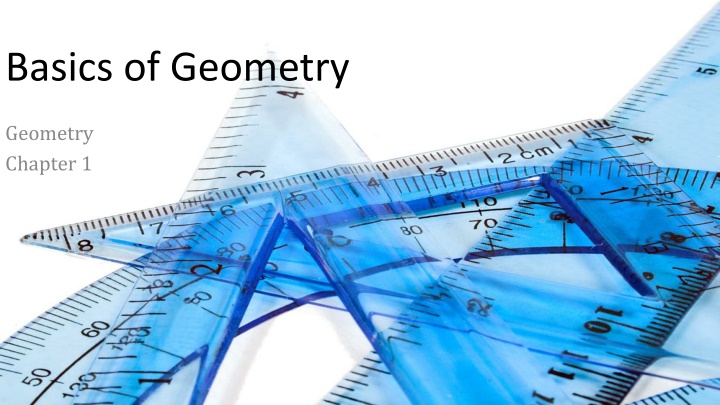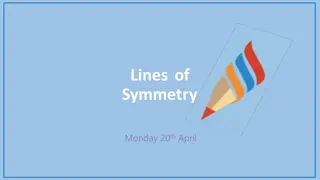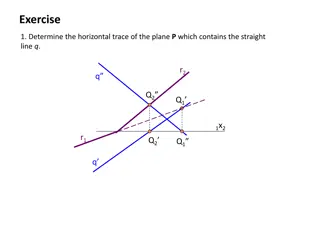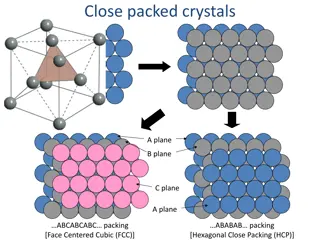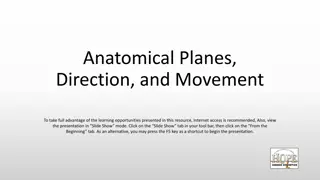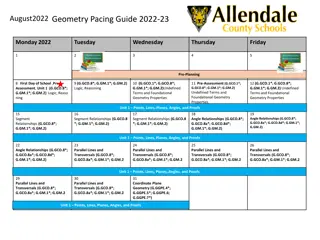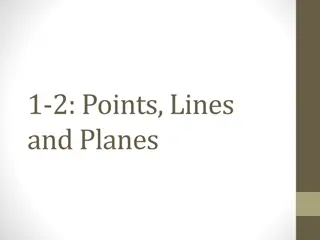Basics of Geometry: Understanding Points, Lines, and Planes
Explore the fundamental concepts of geometry in this slideshow developed to accompany the textbook "Big Ideas Geometry." Learn about points, lines, and planes, their characteristics, how they are named, and their relationships in space. Gain a clear understanding of line segments, rays, collinear points, coplanar points, and more.
Download Presentation

Please find below an Image/Link to download the presentation.
The content on the website is provided AS IS for your information and personal use only. It may not be sold, licensed, or shared on other websites without obtaining consent from the author.If you encounter any issues during the download, it is possible that the publisher has removed the file from their server.
You are allowed to download the files provided on this website for personal or commercial use, subject to the condition that they are used lawfully. All files are the property of their respective owners.
The content on the website is provided AS IS for your information and personal use only. It may not be sold, licensed, or shared on other websites without obtaining consent from the author.
E N D
Presentation Transcript
Basics of Geometry Geometry Chapter 1
This Slideshow was developed to accompany the textbook Big Ideas Geometry By Larson and Boswell 2022 K12 (National Geographic/Cengage) Some examples and diagrams are taken from the textbook. Slides created by Richard Wright, Andrews Academy rwright@andrews.edu
Objectives: By the end of the lesson, I can describe a point, a line, and a plane. I can define and name segments and rays. I can sketch intersections of lines and planes. 1.1 POINTS, LINES, AND PLANES
1.1 Points, Lines, and Planes What is it? What is it like? Dot Undefined Term No Dimension Point A Point A A How is it named?
1.1 Points, Lines, and Planes What is it? What is it like? No Thickness Undefined Term Goes forever Straight m Line A B 1 Dimension m ?? ?? Through any two points there is exactly one line. How is it named?
1.1 Points, Lines, and Planes What is it? What is it like? No Thickness Undefined Term Goes forever in both directions Plane A B ? C 2 Dimensions Plane ? Plane ABC Through any three noncollinear points, there is exactly one plane. How is it named?
1.1 Points, Lines, and Planes Give two other names for ?? Give another name for plane ? ? A D m B Name three collinear points E C Name four coplanar points
1.1 Points, Lines, and Planes What is it? What is it like? Part of a line between two endpoints Part of a Line Segment A B Does NOT go on forever Named by endpoints ?? ?? How is it named?
1.1 Points, Lines, and Planes What is it? What is it like? Part of a line starting at one endpoint and continuing forever Part of a Line Ray A B Goes forever in one direction only Named by endpoint followed by one other point ?? If two rays have the same endpoint and go in opposite directions, they are called opposite rays. How is it named? A B C
1.1 Points, Lines, and Planes Give another name for ?? P T Name all rays with endpoint Q Q Which of these rays are opposite rays? R S The intersection of two lines is a point.
1.1 Points, Lines, and Planes The intersection of two planes is a line.
1.1 Points, Lines, and Planes Sketch a plane and two intersecting lines that intersect the plane at separate points. Sketch a plane and two lines that do not intersect lying in the plane. Sketch a plane and two intersecting lines that lie in the plane. 8 #2, 4, 6, 8, 10, 12, 14, 18, 20, 22, 24, 26, 28, 30, 32, 34, 52, 54, 56, 58
Objectives: By the end of the lesson, I can measure a line segment. I can explain and use the Segment Addition Postulate. 1.2 MEASURING AND CONSTRUCTING SEGMENTS
1.2 Measuring and Constructing Segments Postulate (or Axiom) Rule that is accepted without proof Theorem Rule that is proven -2 -1 0 1 2 3 4 Ruler Postulate Any line can be turned into a number line A B
1.2 Measuring and Constructing Segments What is it? What is it like? Difference of the coordinates of the points Length measurement Distance AB = | x2 x1 | AB BA -2 -1 0 1 2 3 4 How is it named? Find AB A B
1.2 Measuring and Constructing Segments What is it? What is it like? On the segment with the other points as the endpoints Point Placement Between Does not have to be the midpoint A B C A B C What are examples?
1.2 Measuring and Constructing Segments Segment Addition Postulate If B is between A and C, then AB + BC = AC If AB + BC = AC, then B is between A and C AB BC A B AC C 42 Find CD D C 17 E
1.2 Measuring and Constructing Segments Graph X( 2, 5) and Y( 2, 3). Find XY.
1.2 Measuring and Constructing Segments What is it? What is it like? Segments with same length Comparing shapes means segments are exactly alike Congruent Segment = means lengths are equal A C B D ?? ?? What are examples? 16 #2, 4, 8, 10, 12, 14, 16, 18, 20, 22, 24, 26, 28, 30, 34, 38, 40, 41, 46, 48
Objectives: By the end of the lesson, I can find lengths of segments. I can find the midpoint of a segment. 1.3 USING MIDPOINT AND DISTANCE FORMULAS
1.3 Using Midpoint and Distance Formulas What is it? What is it like? Very middle of the segment Part of a Segment Point that divides the segment into two congruent segments. Midpoint B A M AM = MB M is the midpoint of ?? ?? ?? What are some examples? Segment Bisector is something that intersects a segment at its midpoint.
1.3 Using Midpoint and Distance Formulas ?? bisects ?? at Q. If PQ = 22.6, find PN. N M Q O P Point S is the midpoint of ??. Find ST. R S T 5x 2 3x + 8
1.3 Using Midpoint and Distance Formulas Midpoint Formula ?1+ ?2 2 ,?1+ ?2 2 Midpoint = Find the midpoint of G(7, 2) and H( 5, 6)
1.3 Using Midpoint and Distance Formulas The midpoint of ?? is M(5, 8). One endpoint is A(2, 3). Find the coordinates of endpoint B.
1.3 Using Midpoint and Distance Formulas Distance Formula 2+ ?2 ?1 2 ? = ?2 ?1 What is PQ if P(2, 5) and Q( 4, 8)? 24 #2, 4, 6, 8, 14, 16, 18, 20, 22, 24, 26, 28, 30, 32, 34, 44, 46, 48, 50, 59
Objectives: By the end of the lesson, I can classify and describe polygons. I can find perimeters of polygons in the coordinate plane. I can find areas of polygons in the coordinate plane. 1.4 PERIMETER AND AREA IN THE COORDINATE PLANE
1.4 Perimeter and Area in the Coordinate Plane What happens when you leave the door of the birdcage open? What is it? What is it like? Sides are straight segments Shape Sides only intersect at ends Polygon Closed shape No curves What are examples?
1.4 Perimeter and Area in the Coordinate Plane Convex All angles poke out of shape. A line containing a side does NOT go through the middle of the shape. Concave Not convex. (There s a cave .)
1.4 Perimeter and Area in the Coordinate Plane Type of Polygon sides 3 Triangle 4 Quadrilateral 5 Pentagon 6 Hexagon 7 Heptagon 8 Octagon 9 Nonagon 10 Decagon 12 Dodecagon 13 13 gon - n n-gon Number of 4 3 6 5 10 8 7 12
1.4 Perimeter and Area in the Coordinate Plane Classify each polygon by the number of sides. Tell whether it is convex or concave.
1.4 Perimeter and Area in the Coordinate Plane Perimeter (P) Distance around a figure Circumference (C) Perimeter of a circle Area (A) Amount of surface covered by a figure
1.4 Perimeter and Area in the Coordinate Plane Square Side s s Triangle sides a, b, c base b, height h P = a + b + c A = bh c a h b P = 4s A = s2 Rectangle Length Width w P = 2 + 2w A = w Circle diameter d radius r C = 2 r A = r2 r d w
1.4 Perimeter and Area in the Coordinate Plane Describe how to find the height from F to ?? in the triangle. Find the perimeter and area of the triangle.
1.4 Perimeter and Area in the Coordinate Plane Find the area of ABCD with vertices A(1, 3), B(3, 3), C( 2, 3), and D( 4, 3). 32 #2, 4, 6, 10, 12, 16, 18, 20, 24, 26, 36, 38, 39, 40, 42
Objectives: By the end of the lesson, I can measure and classify angles. I can find angle measures. 1.5 MEASURING AND CONSTRUCTING ANGLES
1.5 Measuring and Constructing Angles What is it? What is it like? Two rays with common endpoint (vertex) Shape Angle Formed when two lines cross BAC CAB A B sides How is it named? A vertex C
1.5 Measuring and Constructing Angles Protractor Postulate A protractor can be used to measure angles What is it? What is it like? Difference coordinates of each ray on a protractor Angle measurement Measure m A = |x2 x1| m A m BAC How is it named?
1.5 Measuring and Constructing Angles Classifying Angles Acute Less than 90 Right 90 Obtuse More than 90 Straight 180 It s such a cute angle!
1.5 Measuring and Constructing Angles Find the measure of each angle and classify. DEC B DEA C CEB DEB A E D
1.5 Measuring and Constructing Angles Name all the angles in the diagram. Which angle is a right angle?
1.5 Measuring and Constructing Angles Angle Addition Postulate If P is in the interior of RST, then m RST = m RSP + m PST R P If m RST = 72 , find m RSP and m PST 2x 9 3x + 6 S T
1.5 Measuring and Constructing Angles What is it? What is it like? Angles with same measure Comparing shapes means angles are exactly alike Congruent Angles = means measures are equal ABC DEF What are examples?
1.5 Measuring and Constructing Angles Identify all pairs of congruent angles in the diagram. In the diagram, m PQR = 130 , m QRS = 84 , and m TSR = 121 . Find the other angle measures in the diagram.
1.5 Measuring and Constructing Angles Angle Bisector is a ray that divides an angle into two angles that are congruent. ?? bisects PMQ, and m PMQ = 122 . Find m PMN. N Q P M 41 #2, 4, 6, 8, 10, 12, 16, 18, 20, 22, 24, 26, 28, 32, 34, 36, 38, 46, 61, 69
Objectives: By the end of the lesson, I can identify complementary and supplementary angles. I can identify linear pairs and vertical angles. I can fi nd angle measures in pairs of angles. 1.6 DESCRIBING PAIRS OF ANGLES
1.6 Describing Pairs of Angles What is it? What is it like? Angles that share a ray and vertex Angles Pairs Adjacent Angles Are next to each other Are not inside each other What are examples?
1.6 Describing Pairs of Angles Complementary Angles Two angles whose sum is 90 Supplementary Angles Two angles whose sum is 180 Complementary and Supplementary Angles do not have to be adjacent
1.6 Describing Pairs of Angles In the figure, name a pair of complementary angles, supplementary angles, adjacent angles. Are KGH and LKG adjacent angles? Are FGK and FGH adjacent angles? Explain.
1.6 Describing Pairs of Angles Given that 1 is a complement of 2 and m 2 = 8o, find m 1. Given that 3 is a supplement of 4 and m 3 = 117o, find m 4.
1.6 Describing Pairs of Angles LMN and PQR are complementary angles. Find the measures of the angles if m LMN = (4x 2)o and m PQR = (9x + 1)o.
